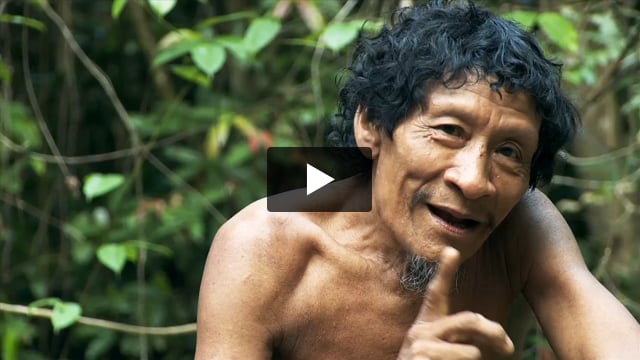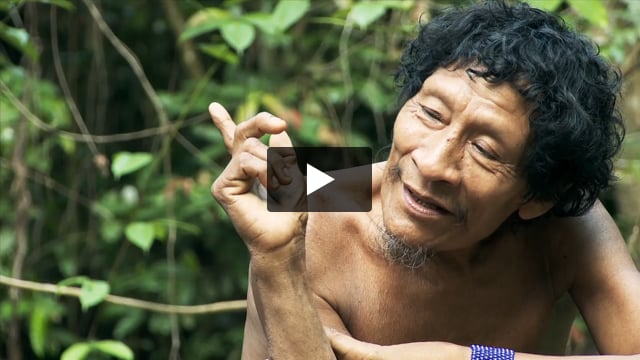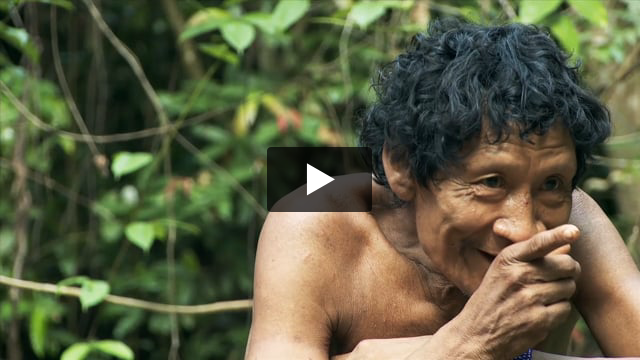The silent years
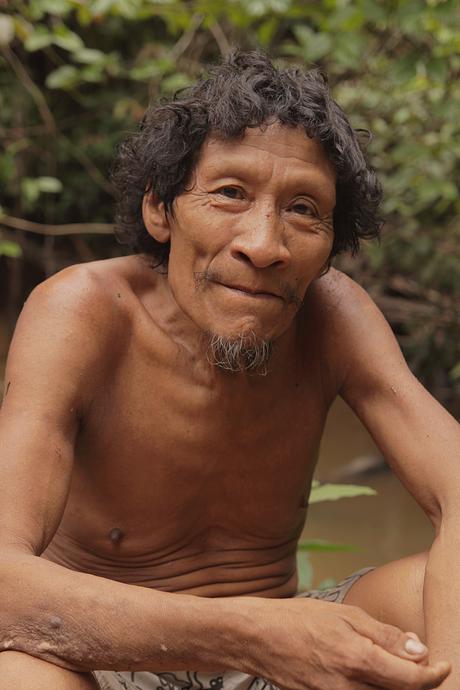
Karapiru’s story of life on the run
His name means ‘Hawk’ in his language. Yet even with the acuity of eyesight the moniker suggests, Karapiru could not have foreseen the tragedy that befell his people, the Awá tribe of north-eastern Brazil. He could never have imagined the day that he would have to flee for his life far into the rainforest, a shotgun pellet burning in his back, his family mown down by gunmen. Nor could he have known that this brutal day would be the first in a decade of solitude and silence.
Karapiru’s ancestral homeland lies in Maranhão state, between the equatorial forests of Amazonia to the west and the eastern savannas. To the Indigenous Awá, the land has only one name: Harakwá, or, ‘the place that we know’.
Today, there are around 520 members of the Awá tribe. They live by hunting for peccary, tapir and monkey, travelling through the rainforest with 6-foot long bows and by gathering forest produce: babaçu nuts, açaí berries and honey. Some foods are considered to have special properties – others, such as vultures, bats and the three-toed sloth, are forbidden. The Awá also travel by night, lighting the way with torches made from tree resin.
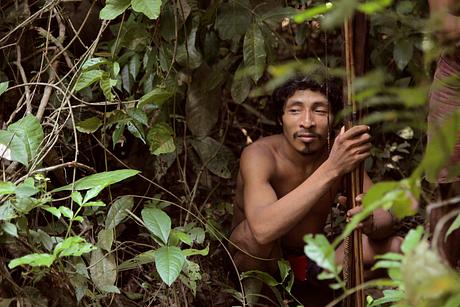
The tribe nurtures orphaned animals as pets, share their hammocks with raccoon-like coatis and split mangoes with green parakeets. Awá women even breast-feed capuchin and howler monkeys and have been known to suckle small pigs.
The Awá year is divided into ‘sun’ and ‘rain’; the rains are controlled by celestial beings called ‘maira’ who oversee vast reservoirs in the sky. When the moon is full, Awá men, their dark hair speckled white with king vulture down, commune with the spirits through a chant-induced trance, during a sacred ritual that lasts until dawn.
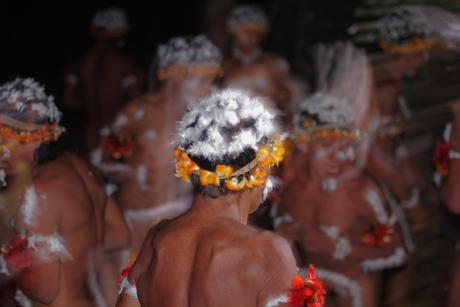
For centuries their way of life has been one of peaceful symbiosis with the rainforest. But in recent decades, they have witnessed the destruction of their homeland and the murder of their people at the hands of ‘karaí’, or ‘non-Indians’. Today they are not only one of the last hunter-gatherer tribes in Brazil, but one of the most threatened tribes on Earth.
Karapiru’s harrowing story really begins with a chance discovery in the late 1960s, when American geologists were carrying out an aerial survey of the region’s mineral resources. When the helicopter needed to refuel, the pilot decided to land on a tree-less summit high in the Carajás Mountains. One geologist reputedly noticed a scattering of black-grey rocks on the ground; he recognised them as iron ore. In fact the soil beneath him contained what a geological magazine would later refer to as, ‘a thick layer of Jaspilites and lenses of hard hematite.’ In layman’s terms, the prospectors had just touched down on the planet’s richest iron ore deposit.
Their discovery swiftly gave rise to the development of the Great Carajas Project, an agro-industrial scheme financed by the U.S., Japan, the World Bank and the then-EEC. It consisted of a dam, aluminium smelters and later included charcoal camps and cattle ranches. Tarmacked roads that destroyed swathes of primary rainforest and a long-distance railway that cut through the Awá tribe’s territory on its 900 km course to the coast were built to transport workers in and minerals out. But the project’s industrial show-piece was a chasm gouged from the forest floor – one so vast that it could be seen from space – and one which would, in time, become the world’s largest open-cast mine.
 © Peter Frey/Survival
© Peter Frey/Survival
The Great Carajás Project was devastating for the region’s environment and its tribal peoples, despite the fact that in return for the billion-dollar loan, the financiers had asked the Brazilian government to guarantee that its Indigenous territories would be mapped and protected.
But there was a fortune to be made from the forest, so a flood of ranchers, settlers and loggers soon began to pour into the region. Huge diggers gouged the land, tearing through layers of soil and rock to reach ore, bauxite and manganese. Rivers were contaminated, ancient trees chopped and burned. The black of charcoal ash replaced the deep green of the forest’s foliage: Harakwá became a polluted, scarred, muddy vision of hell.
To the prospectors, the Awá tribe was nothing more than an obstacle to this treasure trove; a primitive nuisance that needed to be felled together with the trees. The tribe stood between them and the dollars they knew the rocks would release.
So they set about killing them.
Some were inventive in their killings: several Awá died after eating flour laced with ant poison; a ‘gift’ from a local farmer. Others, like Karapiru, were shot where they stood – at home, in front of their families.
Karapiru believed that he was the only member of his family to survive one such massacre. The killers murdered his wife, son, daughter, mother, brothers and sisters. Another son was wounded and captured.
Severely traumatised, Karapiru escaped into the forest, lead shot embedded in his lower back. ‘There was no way of healing the wound. I couldn’t put any medicine on my back, and I suffered a great deal,’ he told Survival’s Fiona Watson. ‘The lead was hot in my back, bleeding. I don’t know how it didn’t become full of insects. But I managed to escape from the whites.’
For the next 10 years Karapiru was on the run. He walked for nearly 400 miles across the forested hills and plains of Maranhão state, crossing the sand dunes of the restingas and the broad rivers that flow into the Atlantic.
He was terrified, hungry and alone. ‘It was very hard,’ he told Fiona Watson. ‘I had no family to help me, and no one to talk to.’ He survived by eating honey and small Amazonian birds: parakeet, dove and the red-bellied thrush. At night, when howler monkeys called from the canopy, he slept high in the boughs of vast copaiba trees, among the orchids and rattan vines. And when the grief and loneliness became too much – ‘sometimes I don’t like to remember all that happened to me’ – he would talk quietly to himself, or hum as he walked.
More than a decade after he had witnessed the murder of his family, Karapiru was seen by a farmer on the outskirts of a town in the neighbouring state of Bahia. He was walking through a burnt section of forest, carrying a machete, a few arrows, some water containers and a chunk of smoked wild pig.
They greeted each other:
Karapiru followed the farmer back to the village, where he found shelter with a local man in exchange for chopping wood. News soon spread that a solitary, ‘unknown’ Indian – one who spoke a language no one else could understand – had emerged from the forest.
He was a man who had spent ten years ‘fleeing from everything’ but his sorrow. ‘It was very sad’, he says. But just as ‘Hawk’ could not have envisaged his long years of suffering, so he could not have predicted the joy that was soon to come.
Read part two of Karapiru’s extraordinary story →
If you want to help fight the atrocities that blighted Karapiru’s life, please join the campaign to #StopBrazilsGenocide. We know Karapiru wanted as many non-Indigenous allies as possible to help his people stop the death and destruction.


